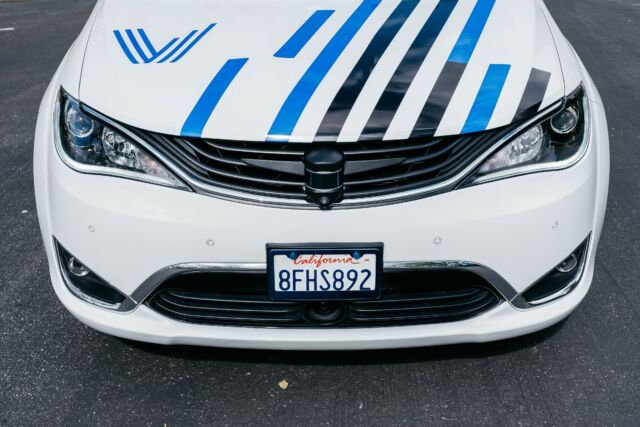This self-driving startup built a “car without wheels” for remote driving

The ideal self-driving car would drive itself all the time, in all situations. But achieving that goal in practice is difficult—so difficult, in fact, that most self-driving companies have provisions for human backup to help cars get out of tricky or confusing situations.
But companies are often secretive about exactly how these systems work. Perhaps they worry that providing details—or even admitting they exist—will cast their self-driving technology in an unflattering light.
So it was refreshing to see the self-driving startup Voyage unveil its remote driving console as if it was announcing a major new product—which, in a sense, it is. Voyage didn’t just create software that allows a remote operator to give instructions to a self-driving car—it built a physical “Telessist Pod” where a remote driver sits to control the vehicle.
Meet the Telessist pod
“For all of this to work safely, it had to basically be a car without wheels,” Voyage CEO Oliver Cameron told me in a Thursday phone interview. “It had to have a real steering wheel, real pedals, real automotive-grade connectors, and real automotive-grade ECUs.”
Voyage’s engineers built a “car without wheels” because they wanted to mirror the experience of driving a real car as closely as possible.
“If you try to do it with a gaming steering wheel, you don’t get the force feedback” you get with a real car, Cameron said. “It’s impossible to drive reliably like that. It’s so unsafe.”
Remote Voyage drivers sit in a metal cage the size of a golf cart. There’s a steering wheel, gas pedal, and brake pedal where you’d expect them in a real car. A wraparound array of computer monitors shows the car’s surroundings.
An encrypted wireless data connection keeps the components in the Telessist pod synchronized with their counterparts in the real car. Voyage says the network latency is under 100 milliseconds—short enough that the driver won’t notice a significant lag.
Three layers of redundancy

The obvious question any engineer is going to ask about a system like this is, “What happens when something goes wrong?” Voyage says it has taken multiple precautions. The company bonds together five separate cellular connections, each with its own SIM card on a different wireless carrier, to achieve maximum redundancy and hence reliability. If one of the five networks fails, software automatically switches over to the other four.
A system called Remote Drive Assist stands ready to take over control if the car loses its wireless connection. “If Remote Drive Assist detects there’s any chance of a dangerous situation during remote operation of the vehicle, it immediately brings the vehicle to a safe stop,” Voyage writes.
A third layer of redundancy is provided by Shield—Voyage’s high-tech emergency braking system. I saw an early version of this system when I visited Voyage headquarters last year. It’s a small, self-contained system that rides on the front of Voyage’s cars. A lidar unit is constantly scanning the road ahead looking for potential obstacles. If it detects an imminent collision, it has the power to activate the brakes and bring the vehicle to a stop. This means that, even if the human driver—or Voyage’s main self-driving system, for that matter—makes a mistake, the car is unlikely to run into anything.
While many cars today have emergency braking technology these days, no car on the market today has a lidar unit as powerful as the ones Voyage is using. So Voyage’s braking technology may be significantly more effective than what you’ll find in conventional cars.
Life in the slow lane

One of Voyage’s key advantages is that its cars have a top speed of 25 miles per hour (40 km/h). Voyage’s initial commercial offering will be a taxi service at the Villages, a massive retirement community in Florida where that’s the maximum speed.
On high-speed freeways, slamming on the brakes can be dangerous, since it can trigger a multicar pile-up. A technology like Voyage’s Shield wouldn’t work—or at least would be much harder to build—for a taxi service that had to navigate highways.
A genius of Voyage’s strategy is that the company has found a potentially large market that can be served without ever exceeding 25mph. The Villages is a community of more than 100,000 seniors, many of them affluent. The community has thousands of homes as well as stores, restaurants, and other amenities spread out over a significant area. Many residents have cars, but some have gotten too old to drive themselves. Cameron believes that the Villages alone could be a $100 million-per-year market.
Meanwhile, companies with more challenging initial markets—Google’s Waymo has a taxi service in suburban Phoenix, while GM’s Cruise is working on serving San Francisco—have struggled to achieve fully driverless operation. Voyage’s bet is that starting with a relatively easy technical challenge will let the company get traction, earn some revenue, and gain knowledge that will help it eventually tackle more challenging environments.
Correction: Voyage’s cellular connection are not 5G as this story previously stated.
https://arstechnica.com/?p=1690893